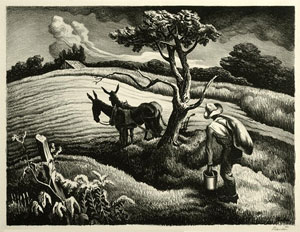
Here we have Thomas Hart Benton’s Approaching Storm. It is a lithograph completed in 1938 most likely in Kansas City. There is no specific information about where it was done but at the time Benton was teaching at the Kansas City Art Institute. I choose this work for two main reasons. First, Benton is one of the only artists of the period that did not completely dive into abstract art. Second, I think it shows very well how European art radically changed due to the war, while at the same time American art remained largely unchanged. At the point that this work was completed, Europe had already undergone all of the variations of abstract art leading up to the second World War. Dada had been around for two decades, surrealism had appeared and spread shortly after, and by the time Benton really started contributing to the art world he was one of the only traditional artists left.
The work itself describes perfectly how the rest of the world was undergoing radical change while life in America was largely untouched. The farmer is out working his fields the same as his family had for generations. I imagine that the storm coming is World War Two, which was about to explode. The extent of the danger ahead is not what it represents, rather it represents what had happened in the previous war. Any educated American would have been aware of the fact that there is no such thing as separatism, if the rest of the world goes to war then America would have no choice but to join.
This piece is a lithograph, a form of art that is not new but is helped considerably by the increases of technology at the time. The original work is done on a metal plate using two types of chemicals, one that absorbs water and one that rejects it. Once the original is complete, it allows an almost unlimited amount of near exact copies to be made. The plate is exposed to paper and ink with water which absorbs into the image exactly however the artist designed it; but as with any new way to mix art and technology, the result is only as good as the artist’s talent, regardless of how easy the technology makes it.




 Here is Peter Paul Rubens The Fall of Phaeton. It was painted in Rome over two years, between 1604 and 1605. Before I critique this work, let me go over the myth which inspired it. Phaeton was a demi-god born of a human woman and Helios, the sun-god who drove the chariot of the sun across the sky every day. Phaeton found his father in Heaven and demanded that he be allowed to drive the chariot himself to prove he really is the son of a god. Eventually Helios gives in, and after putting a magic oil on Phaeton to make sure he is not burned, he hands over the reins to the chariot. The horses immediately sense a weak master at the helm and bolt. Phaeton is unable to control the chariot and after it burns a considerable amount of the earth Zeus sends a bolt of lightning down to destroy the chariot and Phaeton falls to his death.
Here is Peter Paul Rubens The Fall of Phaeton. It was painted in Rome over two years, between 1604 and 1605. Before I critique this work, let me go over the myth which inspired it. Phaeton was a demi-god born of a human woman and Helios, the sun-god who drove the chariot of the sun across the sky every day. Phaeton found his father in Heaven and demanded that he be allowed to drive the chariot himself to prove he really is the son of a god. Eventually Helios gives in, and after putting a magic oil on Phaeton to make sure he is not burned, he hands over the reins to the chariot. The horses immediately sense a weak master at the helm and bolt. Phaeton is unable to control the chariot and after it burns a considerable amount of the earth Zeus sends a bolt of lightning down to destroy the chariot and Phaeton falls to his death.
